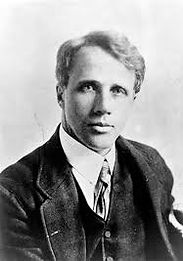Age saw two quiet children
Go loving by at twilight,
He knew not whether homeward,
Or outward from the village,
Or (chimes were ringing) churchward,
He waited (they were strangers)
Till they were out of hearing
To bid them both be happy.Be happy, happy, happy,
And seize the day of pleasure.”
The age-long theme is Age’s.
Twas Age imposed on poems
Their gather-roses burden, to warn against the danger
That overtaken lovers from being overflooded
With happiness should have it.
And yet not know they have it.
But bid life seize the present?
It lives less in the present
Than in the future always, and less in both together
Than in the past. The present is too much for the senses,
Too crowding, too confusing—
Too present to imagine.
Carpe Diem
by Robert Frost
Analysis
The first line in the poem is: “Age saw two quiet children go loving by at twilight.” I think that this line means that a young couple were walking by in the early morning. This line is narrated by age, as is the entire poem. I think that the fact that age is watching the couple means that he will soon affect them in some way. The next three lines in the poem are: “He knew not whether homeward, or outward from the village, or (chimes were ringing) churchward.” This line does not involve any symbolism, except that readers can infer that Age is still watching them, and that he will continue to watch them in order to know where they are headed. The next line is “He waited (they were strangers).” I think that this line shows that the couple is young. This is because anyone unknown to Age is most likely a young person, who has not had much experience with age. The next two lines three lines are: “Till they were out of hearing to bid them both be happy. Be happy, happy, happy, And seize the day of pleasure.” This line shows that Age wanted them to make the most of their youth while they still had it. The next few lines all relate to the safe idea. These lines are: “The age-long theme is Age’s. Twas Age imposed on poems.” I think that this line means that Age has always been the same, even in documentations. The next two lines also form a sentence, which is: “Their gather-roses burden, to warn against the danger.” I think that this means that wasting time on things that do not matter may burden you and put you in the path of danger. The next line is: “That overtaken lovers from being overflooded.” This line makes a reference to the line above, where danger is mentioned. I think that this line means that lover are often overtaken by danger, which often causes them to be distressed. The next two lines, “With happiness should have it, and yet not know they have it,” mean that people often take advantage of good fortune. Then, when they no longer have it, it comes as a surprise. I beleive that the next line, “But bid life seize the present? It lives less in the present,” means that life is all about thinking about the past, which will help in succeeding the future. The next line is “Than in the future always, and less in both together.” This line means that thinking about the future can be good as well, but life is best when only one is consulted at a time. The next line, which is “The present is too much for the senses, Too crowding, too confusing.” I think that this line means that thinking about the future or the past will help in life, while the challenges faced in the present are often overwhelming. The last line, which is “Too present to imagine,” means that not thinking about the past or the future often leaves nothing to the imagination.
Figurative Language:
Personification: "Age saw two quiet children."
This is an example of personification because Age is being given the human-like quality of watching. In the poem, this example of personfication is being used to represent that Age is never far, and that youth is precious.
Metaphor: "Thier gather roses burden, to warn against the danger."
This quote is a metaphor because a warning is being compared to roses. This phrase is being used to show that "gethering roses," which symbolizes wasting time, is a burden. This encourages readers to make better use of thier time.
Personification: "It lives less in the present than in the future always and less on both together."
This phrase is an example of personfication because the human-like quality of living is being given to happiness, which is an idea. In this poem, this phrase is being used to show that happiness is always in the future, as long as it is not in the past. This encourages readers to take advantage of the happy times in thier life.
Tone:
In this poem, the tone is encouraging and joyful. This is because there are many quotes in the text that reflect this thought. These quotes include: "Age saw two quiet children," "bid them both be happy. Be happy, happy, happy," "Thier gather-roses burder, to warn against the danger" and "With happiness should have it."
Mood:
In this poem, the mood is encouraged and full of joy. This is becuase I think this is the way that the author meant for the reader(s) to feel. For this reason, I beleive that this is the mood. Also, many quotes from the text prove my claim, including "Age saw two quiet children," "bid them both be happy. Be happy, happy, happy," "Thier gather-roses burder, to warn against the danger" and "With happiness should have it."
Robert Frost (1874 - 1963)


Poetic Perfection
Created by: Brynn Siles
Teacher: Klaudia Neufeld
Class: 7GT English
Date: 23 November , 2014
School: Hulstrom K-8 School